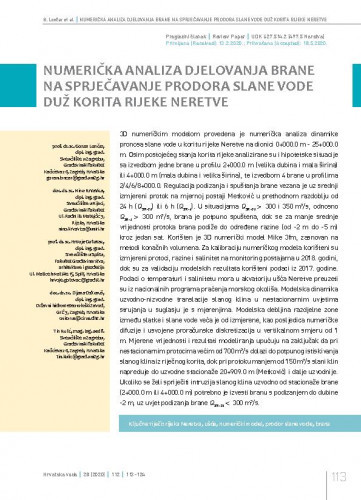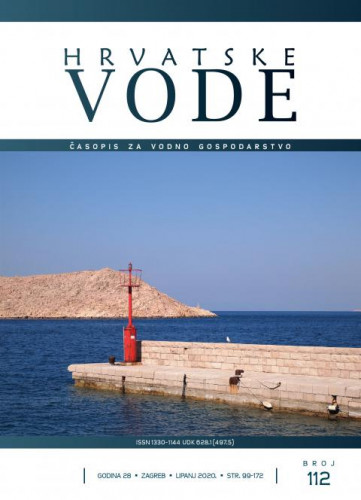3D numeričkim modelom provedena je numerička analiza dinamike pronosa slane vode u koritu rijeke Neretve na dionici 0+000.0 m - 25+000.0 m. Osim postojećeg stanja korita rijeke analizirane su i hipotetske situacije sa izvedbom jedne brane u profilu 2+000.0 m (velika dubina i mala širina) ili 4+000.0 m (mala dubina i velika širina), te izvedbom 4 brane u profilima 2/4/6/8+000.0. Regulacija podizanja i spuštanja brane vezana je uz srednji izmjereni protok na mjernoj postaji Metković u prethodnom razdoblju od 24 h (QSR-24) ili 6 h (QSR-6). U situacijama QSR-24 > 300 i 350 m3/s, odnosno QSR-6 > 300 m3/s, brana je potpuno spuštena, dok se za manje srednje vrijednosti protoka brana podiže do određene razine (od -2 m do -5 m) kroz jedan sat. Korišten je 3D numerički model Mike 3fm, zasnovan na metodi konačnih volumena. Za kalibraciju numeričkog modela korišteni su izmjereni protoci, razine i salinitet na monitoring postajama u 2018. godini, dok su za validaciju modelskih rezultata korišteni podaci iz 2017. godine. Podaci o temperaturi i salinitetu mora u akvatoriju ušća Neretve preuzeti su iz nacionalnih programa praćenja morskog okoliša. Modelska dinamika uzvodno-nizvodne translacije slanog klina u nestacionarnim uvjetima strujanja u suglasju je s mjerenjima. Modelska debljina razdjelne zone između slatke i slane vode veća je od izmjerene, kao posljedica numeričke difuzije i usvojene proračunske diskretizacija u vertikalnom smjeru od 1 m. Mjerene vrijednosti i rezultati modeliranja upućuju na zaključak da pri nestacionarnim protocima većim od 700 m3/s dolazi do potpunog istiskivanja slanog klina iz riječnog korita, dok pri protoku manjem od 150 m3/s slani klin napreduje do uzvodne stacionaže 20+909.0 m (Metković) i dalje uzvodnije. Ukoliko se želi spriječiti intruzija slanog klina uzvodno od stacionaže brane (2+000.0 m ili 4+000.0 m) potrebno je izvesti branu s podizanjem do dubine -2 m, uz uvjet podizanja brane QSR-24 < 300 m3/s.. A numerical analysis of saltwater transfer in the Neretva river bed in the section 0+000.0 m - 25+000.0 mwas conducted using a 3D numerical model. In addition to the existing state of the riverbed, hypothetical situations including a construction of one dam in the profile 2+000.0 m (large depth and small width) or 4+000.0 m (small depth and large width) as well as the construction of 4 dams in the profiles 2/4/6/8+000.0were also analyzed. The regulation of dam lifting and lowering is related to the mean measured discharge at the monitoring station Metković in the previous 24-hour period (QSR-24) or 6-hour period (QSR-6). In the situations where QSR-24 > 300 and 350 m3/s and QSR-6 > 300 m3/s, the dam was fully lowered whereas at smaller mean discharge values the dam is lifted up to a certain level (from -2 m to -5 m) during one hour. The 3D numerical model Mike 3fm, based on the finite volume method, was implemented. The discharges, levels and salinity measured at monitoring stations in 2018 were used for the model calibration and the 2017 data for the model results validation. Data on the sea temperature and salinity in the waters of the Neretva river mouth were taken from the national marine environment monitoring programmes. The model dynamics of the upstream-downstream translation of the salt “wedge” in non-stationary circulation conditions is in line with the measurements. The model thickness of the dividing zone between the freshwater and saltwater is larger than the one measured as a result of the numerical diffusion and adopted discretization of the calculation in the vertical direction of 1 m. The measured values and modeling results point to the conclusion that a complete extrusion of the salt “wedge” from the riverbed occurs at non-stationary discharges larger than 700 m3/s whereas the salt “wedge” advances upstream to 20+909.0 m (Metković) and further at discharges lower than 150 m3/s. If the intrusion of the salt “wedge” upstream of the dam (2+000.0 m or 4+000.0 m) is to be prevented, a dam with a lifting to the depth of -2 m, under the condition of dam lifting at QSR-24 < 300 m3/s, must be executed.
Sažetak
Dio sveska

